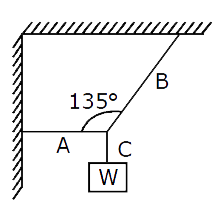Which of the following relations is true?
Y=2η(1−2σ)
Y=2η(1+2σ)
Y=2η(1+σ)
(1−σ)2η=Y
To determine which of the given relations is true, we need to analyze the definitions and relationships between the different mechanical properties of solids: Young's modulus (γ), modulus of rigidity (η), and Poisson's ratio (σ).
1. Identify the Definitions:
- Young's Modulus (γ) is defined as the ratio of tensile stress to tensile strain.
- Modulus of Rigidity (η), also known as shear modulus, is defined as the ratio of shear stress to shear strain.
- Poisson's Ratio (σ) is the ratio of the transverse strain to the axial strain in a material subjected to axial stress.
2. Understand the Relationships:
- There are established relationships between these moduli. One important relationship is:
γ=2η(1+σ)
- This equation indicates how Young's modulus (γ) relates to the modulus of rigidity (η) and Poisson's ratio (σ).
3. Evaluate the Options:
- Given that we have the relation γ=2η(1+σ), we can conclude that this is a valid expression.
- If the options provided include this relation, then it is the correct answer.
4. Conclusion:
- After analyzing the definitions and relationships, we find that the correct relation is:
γ=2η(1+σ)
- Therefore, the correct option is option number 3.
Final Answer:
The correct relation is γ=2η(1+σ), which corresponds to option number 3.
- Young's Modulus (γ) is defined as the ratio of tensile stress to tensile strain.
- Modulus of Rigidity (η), also known as shear modulus, is defined as the ratio of shear stress to shear strain.
- Poisson's Ratio (σ) is the ratio of the transverse strain to the axial strain in a material subjected to axial stress.
- There are established relationships between these moduli. One important relationship is:
γ=2η(1+σ)
- This equation indicates how Young's modulus (γ) relates to the modulus of rigidity (η) and Poisson's ratio (σ).
- Given that we have the relation γ=2η(1+σ), we can conclude that this is a valid expression.
- If the options provided include this relation, then it is the correct answer.
- After analyzing the definitions and relationships, we find that the correct relation is:
γ=2η(1+σ)
- Therefore, the correct option is option number 3.
The correct relation is γ=2η(1+σ), which corresponds to option number 3.
Topper's Solved these Questions
- MECHANICAL PROPERTIES OF SOLIDSBOOK - AAKASH INSTITUTECHAPTER - MECHANICAL PROPERTIES OF SOLIDSEXERCISE - Assignment(Section-D)
12 Videos
- MECHANICAL PROPERTIES OF SOLIDSBOOK - AAKASH INSTITUTECHAPTER - MECHANICAL PROPERTIES OF SOLIDSEXERCISE - Assignment(Section-B)
24 Videos
- MECHANICAL PROPERTIES OF FLUIDSBOOK - AAKASH INSTITUTECHAPTER - MECHANICAL PROPERTIES OF FLUIDSEXERCISE - SECTION - J
9 Videos
- Mock test 03BOOK - AAKASH INSTITUTECHAPTER - Mock test 03EXERCISE - EXAMPLE
37 Videos
Similar Questions
If the upper and lower limits of a class are x and y respectively and l be the length of the class, then which of the following relation is true?
View SolutionThe maximum intensity of fringes in Young's experiment is I. If one of the slit is closed, then the intensity at that place becomes Io. Which of the following relation is true?
View Solution
Knowledge Check
Which of the following relation is true ?
AY=2η(1−σ)BY=2η(1+2σ)CY=2η(1−σ)D(1+σ)2η=YWhich of the following relation is true ?
AY=2η(1−2σ)BY=2η(1+2σ)CY=2η(1−σ)D(1+σ)2η=YMaximum and minimum magnitudes of the resultant of two vectors of magnitudes P and Q are in the ratio 3:1. Which of the following relation is true?
AP=2QBP=QCPQ=1Dnone of these
The maximum intensity of fringes in Young's double-slit experiment is I. if one of the slit is closed, the intensity at that place becomes I0. Which of the following relation is true ?
View SolutionThe maximum intensity of fringes in Young's experiment is I. If one of the slit is closed, then the intensity at that place becomes Io. Which of the following relation is true?
View SolutionA block of weight W is supported by three strings as shown in figure. Which of the following relations is true for tension in the string ? (Here, T1,T2 and T3 are the tension in the strings A,B and C respectively)

View SolutionIf x=(0.08)2,y=1(0.08)2andz=(1−0.08)2−1 then which of the following relation is true?
View SolutionEqual molecules of two gases are in thermal equilibrium. If Pa,PbandVa,Vb are their respective pressures and volumes, then which of the following relation is true?
View Solution
